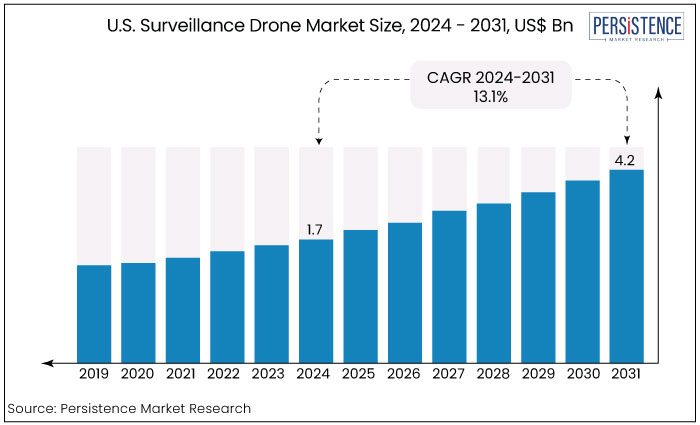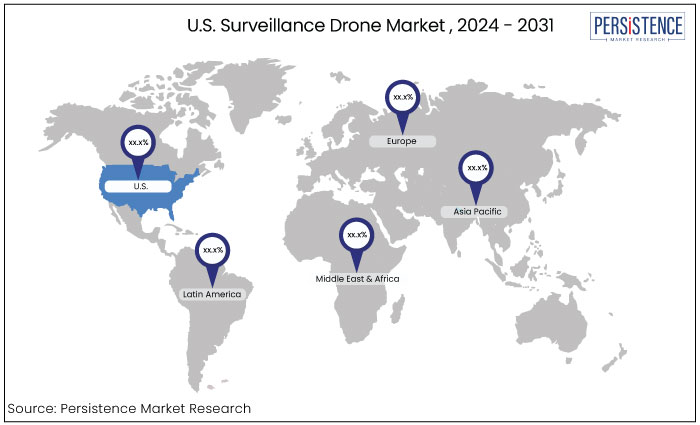U.S. Surveillance Drone Market
Industry: IT and Telecommunication
Published Date: October-2024
Format: PPT*, PDF, EXCEL
Delivery Timelines: Contact Sales
Number of Pages: 171
Report ID: PMRREP34845
The U.S. surveillance drone market is estimated to increase from US$1.7 Bn in 2024 to US$4.2 Bn by 2031. The market is projected to secure a remarkable CAGR of 13.1% during the forecast period from 2024 to 2031.

Key Highlights of the Market
|
Market Attributes |
Key Insights |
|
Market Size (2024E) |
US$1.7 Bn |
|
Projected Market Value (2031F) |
US$4.2 Bn |
|
North America Market Growth Rate (CAGR 2024 to 2031) |
13.1% |
|
Historical Market Growth Rate (CAGR 2019 to 2023) |
8.7% |
|
Category |
Market Share in 2024 |
|
Type - Fixed Wing |
52.7% |
Fixed-wing drones are expected to dominate the U.S. surveillance drone market, accounting for 52.7% of the total market share. This significant contribution can be attributed to several advantages that fixed wing drones offer over their multi-rotor counterparts.
Fixed-wing drones are designed for longer flight durations and can cover larger distances, making them ideal for extensive surveillance missions such as border monitoring, agricultural assessment, and infrastructure inspections. Their aerodynamic design allows for more efficient fuel consumption, enabling prolonged operations without the need for frequent recharging or refueling.
Fixed wing drones can carry heavy payloads including advanced cameras and sensor equipment, which enhances their surveillance capabilities. This versatility allows them to be utilized in various applications from military reconnaissance to environmental monitoring.
As industries increasingly recognize the value of surveillance drones for data collection and analysis, the demand for fixed-wing models is likely to grow. The combination of long flight times, and the ability to carry sophisticated equipment positions fixed wing drones as the preferred choice for many surveillance applications, solidifying their status as the largest contributor in the market.
|
Category |
Market Share in 2023 |
|
Application- Pipeline Monitoring and Inspection |
20% |
Pipeline monitoring and inspection held 20% market share in 2023 dominating the industry. The pipeline monitoring and inspection segment continues to hold a dominant position in the surveillance drone market. It is driven by the critical need for efficient and effective monitoring of extensive pipeline networks across various industries, including oil and gas, water, and utilities.
Drones equipped with advanced imaging technology and sensors enable operators to conduct thorough inspections of pipelines, identifying leaks, corrosion, and other potential issues that could lead to costly environmental disasters or operational disruptions.
The surveillance drone market has experienced significant growth driven by advancements in technology and an increasing demand for efficient monitoring solutions across various sectors. Initially introduced for military applications, drones are now widely adopted in commercial industries such as agriculture, infrastructure, and environmental monitoring.
The evolution of drone technology including enhanced battery life, improved sensors, and artificial intelligence (AI), has expanded their capabilities making them more versatile and effective.
Current trends in the market include the integration of AI and machine learning, enabling drones to process vast amounts of data and perform autonomous inspections and monitoring tasks. This technological shift enhances the accuracy and efficiency of surveillance operations, reducing the need for human intervention.
The growing focus on sustainability and environmental protection is driving the demand for drones in monitoring emissions and assessing ecological impacts. Regulatory frameworks are also evolving to facilitate the safe integration of drones into airspace further boosting market growth.
As industries increasingly recognize the value of drones for real-time data collection and analysis, the surveillance drone market is poised for continued expansion with emerging applications and innovations promising to redefine how monitoring and inspection tasks are performed across various sectors.

The surveillance drone market experienced robust growth between 2019 and 2023, driven by increasing demand from various sectors, including defense, agriculture, and infrastructure. The market was propelled by advancements in drone technology, such as enhanced imaging systems, artificial intelligence, and data analytics capabilities.
Regulatory changes also played a significant role, as governments worldwide began to establish frameworks that permitted the commercial use of drones leading to wide adoption in industries previously restricted to traditional monitoring methods.
The market is projected to continue its upward trajectory with a CAGR of 13.1% during the forecast period from 2024 to 2031. Key factors driving this growth include the rising emphasis on operational efficiency, the need for real-time data collection, and increasing investment in drone technology.
Emerging applications, such as disaster response, environmental monitoring, and smart city initiatives, will further enhance market opportunities. Additionally, advancements in battery life, payload capacity, and autonomous flight capabilities are expected to expand the operational range and versatility of surveillance drones.
As industries increasingly recognize the benefits of drone technology, the surveillance drone market is set for significant expansion, transforming monitoring and inspection practices across various sectors.
Increase in Security Concerns Remains a Primary Driver
Increased security concerns are significantly driving the U.S. surveillance drone market growth. As threats to public safety rise, the demand for advanced monitoring solutions becomes paramount.
Drones are utilized extensively for surveillance of critical infrastructure, border security, and law enforcement operations, enabling real-time data collection and enhanced situational awareness. Moreover, their ability to provide aerial perspectives and cover vast areas makes drones an effective tool for preventing and responding to security incidents. This trend is further amplified by the need for proactive threat detection, especially in urban settings where traditional surveillance may be limited.
Regulatory Restrictions Pose a Key Barrier
The market for surveillance drones in the U.S. faces several significant challenges. Regulatory restrictions pose a key barrier, as stringent regulations from the Federal Aviation Administration (FAA) and privacy laws limit drone operations, particularly in urban areas.
Additionally, high costs associated with purchasing and maintaining advanced surveillance technology can deter potential buyers especially among small organizations. Public concerns about privacy and data security further complicate market growth, as negative perceptions may lead to backlash against drone usage.
Technological limitations such as battery life and payload capacity hinder the effectiveness of drones for extended surveillance missions. Competition from alternative technologies including satellite imagery and traditional surveillance system can impede the adoption of drones in various sectors.
The U.S. surveillance drone market presents numerous future opportunities for industry players as demand continues to grow. Key areas of potential include the integration of advanced technologies like artificial intelligence (AI) and machine learning, which can enhance data analysis and decision-making processes?.
Expanding applications in sectors such as agriculture, construction, and disaster response create new revenue streams. Companies can also focus on developing specialized drones for niche markets such as thermal imaging and wildlife monitoring catering to specific client needs.
Strategic partnerships with governmental agencies can facilitate access to lucrative contracts, particularly for critical infrastructure monitoring and urban security initiatives. As regulations evolve to accommodate drone operations, businesses that innovate and adapt to these changes will likely to capitalize on the increasing acceptance of drones as essential tools for security and surveillance.
The U.S. surveillance drone market includes a wide variety of companies from large defense firms to newer startups, all offering advanced technology and solutions. Competition in this industry is fueled by progress in artificial intelligence (AI), and self-driving systems making drones more capable.
Leading companies are concentrating on growing their product offerings, winning government contracts, and creating new uses for drones in both military and commercial fields.
Recent Developments in the U.S. Surveillance Drone Market
|
Attributes |
Details |
|
Forecast Period |
2024 to 2031 |
|
Historical Data Available for |
2019 to 2023 |
|
Market Analysis |
US$ Billion for Value |
|
Key Country Covered |
|
|
Key Market Segments Covered |
|
|
Key Companies Profiled |
|
|
Report Coverage |
|
|
Customization & Pricing |
Available upon request |
By Type
By Application
By Mode of Operation
By Zone
To know more about delivery timeline for this report Contact Sales

The market is estimated to increase from US$1.7 Bn in 2024 to US$4.2 Bn by 2031.
Increasing demand for public safety and security demand for ethnic flavors is a key driver for market growth.
Some of the leading industry players in the market are Aerodyne Group, Aesthetix Global, and Airobotics Ltd.
The market is projected to record a CAGR of 13.1% through 2031.
A key opportunity lies in the increasing demand for drones in border surveillance and national security.